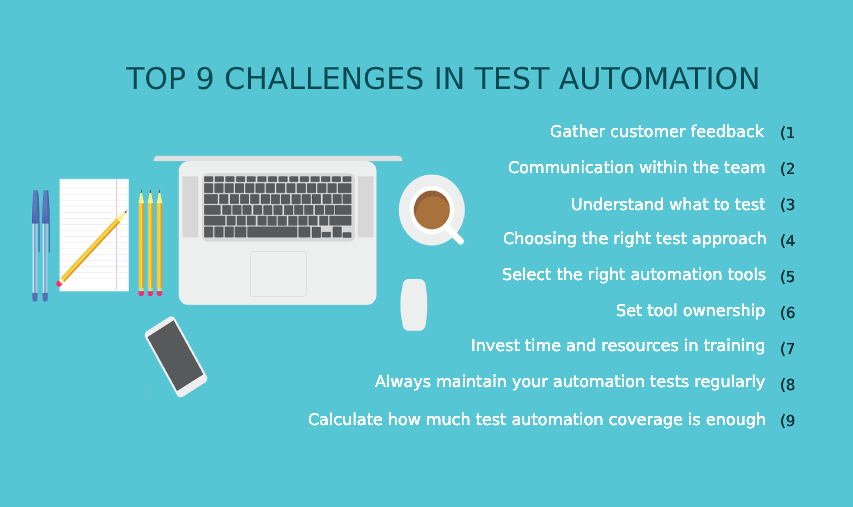
To have a high-quality stable product you need to have effective test automation depending on your test strategy. It is a big plus on the productivity of the project when done correctly. Considering the scope you have for covering as many cases as you possibly can, you need to focus on how can automation testing be performed correctly, what are the constraints, dependencies, and challenges. In this post, we’re going to take a look at the top 9 challenges in test automation that many of us are facing today.
Gather customer feedback

Understand what the customer actually wants, what are his goals, and what he’s trying to achieve by creating this product. Gather all the information you need and translate that into a beautiful piece of code that simulates user scenarios to achieve the end goals which is product stability and satisfying customer needs. Customer feedback is really important since it gives you the perspective of what you are actually automating. Also, it provides a great level of confidence to know that you are testing the right stuff as per the end-user requirements. Software testers can get a great understanding of this since it allows them to create more reliable, more stable, and more precise automation tests.
Communication within the team

Often, bad or not enough communication within the team can result in many project issues like missing the deadline for the release, not enough automation coverage, not testing the right functionality, etc. It is key to the process of automation testing. Testers, developers, analysts, and managers need to be involved in daily discussions that can prevent this from happening. But as far as automation testing goes, it can greatly degrade the performance of the testers if the work is not done the way it supposed to be done. The miscommunication between the team needs to be improved. That way testers can rely on the information gathered from the meetings and can have big confidence in what they are automating.
Let me show you an example.
Let’s say we have a release coming up and we need automation test coverage for the whole feature. A meeting is set in place to discuss the steps needed to develop, test, and release the feature to production. There is a miscommunication of how large is the automation part of this feature and what are the scenarios. Someone missed the fact that a couple of the most important features needs to be covered as well.
Testers rely on the acceptance criteria set from the meeting notes and try to automate test scripts based on those criteria. In this case, the most important cases were not covered and the application is at potential risk, even if those scenarios work as expected, they are at risk because there’s always a chance something could go wrong with those scenarios and we don’t have an automation coverage for them. It could lead to issues on production to creating hotfixes that everyone tries to avoid.
Understand what to test

Be clear on how the flow of the features is constructed in order to know what to test. If you understand the logic behind it and understand how components are structured and coupled together, how they communicate and what to expect if we pass some unexpected values, then we can create a test design procedure to set the entry criteria, exit criteria, preconditions, steps as well as actual vs expected result. That way we can have an understanding of what to test.
Choosing the right test approach
Once you understand what to test, it’s time to choose the right test approach you’re going to be doing. Either you opt for context-driven, exploratory testing or session-based testing, scenario-based, etc. Every approach has its advantages and disadvantages and what you choose depends on the nature of the product, management decision, and team communication.
Select the right automation tools

Not every tool is compatible with your test approach so it’s wise that the team and its management decide what tools should be selected for automation purposes. But as always, few things need to be considered first. The cost for licenses and regular maintenance for the tool, whether it can be integrated with your existing systems and how it can show value to the organization? Should it be easy to use or not and what training needs to be performed in order to prepare the software testers? The complexity of the tool can also lead to different opinions within the team for its usage.
Set tool ownership
Once you decide what tool should you use for your automation process, it is best practice and a moral thing to do to set an owner/s for the tool. They can be responsible for many aspects including:
- Maintain an up to date third party dependency versions
- Set runner configurations
- Write default helper methods to be reused within the automation framework
- Install and maintain needed plugins for executing and reporting tests
- Introduce new assert solutions
- Maintain performance execution
With an owner in place, it is much easy to introduce new changes or refactor existing ones. The owner should be the first point of contact if we need to do something like this and it could be of great help to discuss potential patterns or code approaches.
Invest time and resources in training

Not every software tester in the organization is familiar with the set of tools selected for its automation purposes. Proper training should be taken into consideration for every non-technical QA or tester with no knowledge of the tools. It is not easy to automate a test scenario since it requires the QA to have coding knowledge and code patterns experience. Once you provided the training, you need to give them additional resources to learn and stay up to date with the latest technologies since the goal of the organization is to move forward in parallel with the automation trends.
Always maintain your automation tests regularly

Your job is not done once you cover all of the test cases with automation scripts. It’s just getting started. You need to be checking them regularly, especially when multiple teams are working within one framework using the same dependencies. There’s a big chance that someone will change the version of the dependency or plugin or a method helper which will affect your tests.
Maybe new functionality is introduced that affects the existing ones and requires a regression testing to be performed or there’s a change with the existing feature. All of that is the reason why you should keep an eye on your automated tests. Maintain them regularly, optimize them, refactor them if needed, reorganize them in separate modules, etc.
Calculate how much test automation coverage is enough
How to know when is enough? There is no specific number or pinpoints to follow on how much is enough. You make sure you cover as many as you can, maybe cover some of the cases that are not reproducible by the end-user but you as a tester can reproduce them. This is to ensure that all aspects of the application outside of its using capabilities are tested. It is not recommended, it’s nice to have. Remember that there is no something like “that’s enough coverage”. Even if something in the network is changed could maybe require another test or application behaving differently. Keep in mind all of the challenges in test automation you will face and happy testing.
Latest Post
- Test Analyst’s Responsibilities in Risk-Based Testing
- Crucial Aspects Of Superior Test Code Quality
- Streamline Your Cucumber BDD Tests with Gherkin Lint: A Comprehensive Guide
- How to Test Authentication and Authorization with Confidence + Best Tips
- Exploring the Three Scrum Artifacts: Grasping Their Essence and Effective Utilization
Share this post












